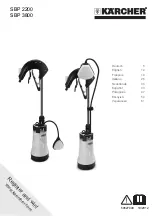
©2005, KEPCO, INC
228-1512
7/30/08
Data subject to change without notice
KEPCO, INC.
"
131-38 SANFORD AVENUE
"
FLUSHING, NY. 11352 U.S.A.
"
TEL (718) 461-7000
"
FAX (718) 767-1102
http://www.kepcopower.com
"
email: [email protected]
KEPCO
®
KLP QUICK REFERENCE GUIDE
This quick reference guide briefly outlines a simple approach to accomplishing common tasks covered in the KLP Operator’s Manual,
and includes references to appropriate paragraphs, Tables and Figures and Kepco website pages for more details.
INITIAL SETUP INSTRUCTIONS
1.
Location
: Do not obstruct front and rear panel vents; additional clearance at side, top and bottom vents is recommended.
2. Connect power supply output to load:
• Voltage drop must be less than 0.25V per conductor (see Nomograph1 at http://www.kepcopower.com/nomomax.htm)
• Local error sense operation is factory default; for remote error sense operation see PAR 2.7.5.1.
• For parallel operation of two or more power supplies see PAR 2.7.7.
• For series operation of two or more power supplies see to PAR 2.7.6.
3. Connect remote programming cables (if applicable):
Only one remote programming input may be active at a time.
•
Remote analog programming:
connect programming cable between programming source and J2 on rear panel of power sup-
ply; see Table 2-6 and PAR 3.7.
•
Digital programming using GPIB:
connect programming cable between host computer and J4; see Table 2-3 and PAR 3.5.
•
Digital programming using RS 232:
Connect programming cable between host computer and J3; see Table 2-4 and PAR 3.4.
4. Connect power supply to power source using one of the following:
See PAR 2.7.2 for additional information.
• Standard NEMA line cord set from Kepco, see Table 1-4.
• Customized line cord using user-wireable mating connector (supplied) in conjunction with user-selected line cord or discrete
wiring as applicable.
• Source power branch current rating and overload protection recommendations:
• For 90 - 136V a-c source power, use 20 amp rated service.
• For 180 - 264V a-c source power, use 15 amp rated service.
5.
Apply source power:
Set Power ON/OFF circuit breaker/switch on front panel to ON. Apply firm, continuous pressure to rocker
actuator until fully engaged (right side of rocker actuator locked parallel to front panel). If actuator does not lock when released,
allow actuator to return to starting position, then wait a few seconds before repeating turn-on sequence. DO NOT attempt to
"tease" the switch contacts closed by repetitive press-and-release action. The circuit breaker is "trip-free" design; if overload
exists, contacts cannot be held closed by actuator.
LOCAL OPERATING MODE INSTRUCTIONS
How do I enable/disable the output?
Press DC OUTPUT to toggle output on and off.
The output cannot be enabled while SET
appears in the status display; tap either knob to exit setpoint mode
. The output can be disabled at any time. VOLTS and AMPS dis-
plays show actual output parameters as determined by the load (see PAR. 3.2.3).
How do I establish the operating mode?
CV and CC indicators light to show operating mode as determined automatically by the
programmed settings and the load. If voltage across the load produces a current that is less than the programmed Current setpoint,
unit operates in CV mode (voltage programmed to voltage setpoint, current limited by current setpoint). If load changes so that cur-
rent through the load reaches the current setpoint, the unit automatically enters CC mode (current programmed to current setpoint,
voltage limited by voltage setpoint) (see PAR. 3.2.6).
How do I adjust output voltage or current (real-time)?
Enable the output. If in CV mode (indicator lit) rotate Voltage knob until
VOLTS display shows desired output voltage. If in CC mode (indicator lit) rotate Current knob until AMPS display shows desired out-
put current. Rotating the knob controlling limit (Voltage in CC mode, Current in CV mode), changes the limit but it is not visible
because actual outputs are displayed on VOLTS and AMPS displays (see PAR. 3.2.6.1).
How can I see what the voltage and current setpoints are?
Tap (press and release) either Voltage or Current knob once to enter
setpoint mode (status reads SET). VOLTS and AMPS displays show the setpoints. Tap either knob once to exit setpoint mode (SET
disappears) (see PAR. 3.2.6.2).
How do I change voltage and current setpoints (enter and exit setpoint mode)?
Setpoint mode can be entered with output
enabled or disabled, but
output CAN NOT be enabled while setpoint mode is active
Tap (press and release) either Voltage or Current
knob once to enter setpoint mode (status reads SET). Rotate Voltage and Current knobs until desired values appear in VOLTS and
AMPS displays; pressing and holding control knob in while turning provides fine adjustment. Tap either knob once to exit setpoint
mode (SET disappears) (see PAR. 3.2.6.2).
What happens when setpoint mode is exited?
If the output is enabled, exiting setpoint causes output to jump to new setpoints,
VOLTS and AMPS show actual output determined by load (e.g., in CV the current setpoint is a limit, and the load will draw less than
this value while in CV mode). If the output was disabled prior to or while in setpoint, exiting setpoint stores the new settings in mem-
ory and causes VOLTS and AMPS to show actual output; then when output is enabled, output jumps to programmed setpoints and
VOLTS and AMPS show output values as determined by the load (see PAR. 3.2.6.2).
How do I enter a Password?
Password required to set Virtual Model or calibrate the unit. Status shows PASS (password) and Cur-
rent Display shows 0000. Rotate Current knob to select a number from 0-9. Tap Current knob to advance to next digit. Repeat until all
four digits have been selected. Tap DC OUTPUT to accept the number. See Table 4-1 for default passwords.
THE POWER SUPPLIER™
Summary of Contents for KLP SERIES
Page 2: ......
Page 6: ......
Page 14: ...viii KLP073008 FIGURE 1 1 KLP SERIES POWER SUPPLY...
Page 21: ...KLP 073008 1 7 FIGURE 1 3 KLP SERIES POWER SUPPLY MECHANICAL OUTLINE DRAWING SHEET 2 OF 2...
Page 26: ......
Page 40: ......
Page 86: ......


































